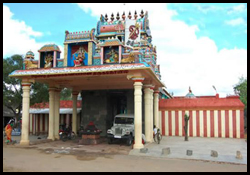Thillai Natarajah Temple, Chidambaram - Chidambaram Thillai Natarajar-Koothan Kovil or Chidambaram temple is a Hindu temple
dedicated to Lord Shiva located in the centre of the temple town of Chidambaram, east-central Tamil Nadu, South India.
Chidambaram is a temple complex spread over 40 acres (160,000 m2) in the heart of the city. It is truly a large temple which is
completely used for religious purpose. The main complex to Lord Shiva Nataraja also contains shrines to deities such as Sivakami Amman, Ganesh, Murugan and Vishnu in the form Govindaraja Perumal.
Thillai Natarajah Temple, Chidambaram (Chidambaram Thillai Natarajar-Koothan Kovil or Chidambaram temple) is a Hindu temple
dedicated to Lord Shiva located in the town of Chidambaram, East-Central Tamil Nadu, South India. The temple is known as the
foremost of all temples (Kovil) to Saivites and has influenced worship, architecture, sculpture and performance art for over two
millennium. The temple is referred to in all devotional literature as Bhooloka Kailasam, or Kailasam, The Lord Shiva's abode that
manifests on earth. The Sangam classics list chief architect Viduvelvidugu Perumtaccan as directing an early renovation of the
shrine.
A major shrine of Lord Shiva worship since the classical period, there have been several renovations and offerings to
Chidambaram by the Pallava, Chola, Pandya, Vijayanagara and Chera royals in the ancient and pre-medieval periods. The temple as
it stands now is mainly of the 12th and 13th centuries, with later additions in similar style. Its bronze statues and stone sculptures
depicting various deities and the famous Thillai trees (Excoecaria agallocha) of the surrounding forest reflect the highpoints of early
Chola and Pallava art while its famed gold plated gopuram towers are medieval structural additions by the royals Aditya I, Parantaka
Chola I, Kopperunchinga I, Krishnadevaraya and Jatavarman Sundara Pandyan. King Kocengannan Chola was born following
prayers his parents offered at the temple and later in his life he refined its structure. The shrine gave the town its name.
The deity that presides here is கூத்தன் - Thillai Koothan (Thillai Nataraja - Shiva, The Lord of Dance). Chidambaram is the
birthplace of the sculpture and bronze image representation of Lord Shiva as the cosmic dancer, a Tamilian concept and motif in
Chola art that has since become notable as a symbol of Hinduism.The shrine is the only Shiva temple to have its main deity
represented in this anthropomorphic form, as the supreme being who performs all cosmic activities. The consort deity here is
Sivakami Amman (form of Amman - mother goddess and female energy). Two other forms of Lord Shiva are represented close to
this in the vimana (inner sanctum) of the temple - as a crystallised lingam - the most common representation of Lord Shiva in
temples, and as the aether space classical element, represented with empty space and a garland of fifty one hanging golden vilvam
leaves (Aegle marmelos). Lord Shiva is captured in pose as Nataraja performing the Ananda Tandava ("Dance of Delight") in the
golden hall of the shrine Pon Ambalam (பொன் அம்பலம்). The sculptures of Chidambaram inspired the postures of Bharatha
Natyam. The Chidambaram complex is admired for its five famous halls (ambalam or sabhai), several grand smaller shrines to the
Hindu deities Ganesh, Murugan, Vishnu and Sivakami Amman which contain Pandyan and Nayak architectural styles, and for its
endowment from many water tanks, one of which links it to the Thillai Kali temple.
Chidambaram is one of the five Pancha Bootha Sthalams, the holiest Shiva temples each representing one of the five classical
elements; Chidambaram represents akasha (aether). Chidambaram is glorified in Tirumular's Tirumandhiram and was visited by
Patañjali and Pulikaal Munivar.[10] It is the primary shrine of the 275 Paadal Petra Sthalams - Shiva Sthalams glorified in the early
medieval Tevaram poems by Tamil Saivite Nayanar saints Tirunavukkarasar, Thirugnana Sambandar and Sundarar. Hailed in the
Tiruvacakam series by Manikkavacakar, these very volumes of the Tirumurai literature canon were themselves found in secret
chambers of the temple. The Periya Puranam, a biography of these Nayanar saints by Sekkizhar commissioned by emperor
Kulothunga Chola II, was written in the shrine's Thousand Pillared Hall. In Kanda Puranam, the epic authored by Kachiyappa
Sivachariar of Kanchipuram, the Chidambaram shrine is venerated as one of the three foremost Shiva abodes in the world,
alongside Koneswaram temple of Trincomalee and Mount Kailash.
